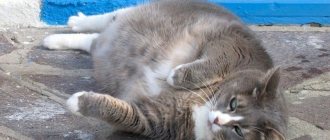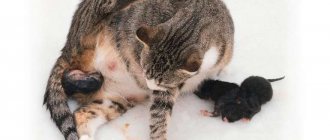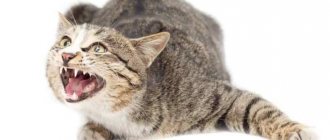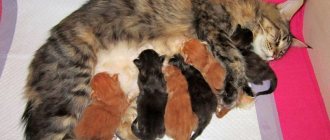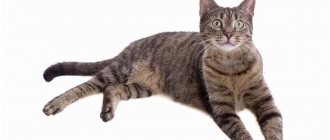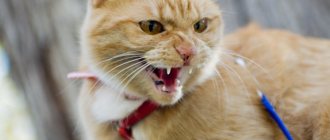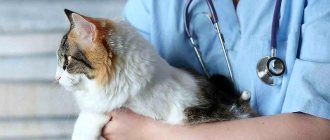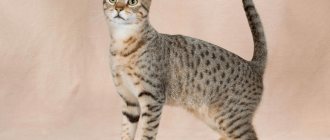Pregnancy in a cat is a period that requires increased attention from the owner. At such times, the animal needs special care. The development and health of kittens largely depends on the pet’s lifestyle. It is necessary to promptly determine and notice that the cat will soon become a mother. You also need to adjust her physical activity and nutrition. Every pet owner should know how pregnancy progresses in cats, and what changes occur in its body and behavior. During this period, the animal must be under the supervision of a veterinarian. The specialist will give useful recommendations regarding the animal’s diet and lifestyle, and will also monitor possible pathologies in a timely manner.
How to recognize pregnancy in a cat?
Only an ultrasound examination in a veterinary clinic can give the most accurate results. It should be carried out 2 weeks after mating. At this stage, embryos that are just beginning to form will already be visible. At week 3, the heartbeat of the embryos will be determined by ultrasound. This indicates that the future kittens are viable and developing correctly.
It is impossible to notice external signs of pregnancy in a cat during the first 2 weeks. The behavior of the animal in the early stages remains the same. Some changes will only be visible after 3 weeks:
- The cat becomes sleepy. She lies down most of the day. Normally, the animal sleeps 14 hours a day; during the period of gestation of kittens, sleep increases by about 4 hours.
- Appetite decreases. At the same time, the pet drinks with pleasure, but does not want to eat solid food, especially dry food. This is an early sign of pregnancy in a cat; in later stages, she begins to eat heavily.
- The animal feels nauseated and sometimes vomits. These symptoms are worse in the morning and can occur up to 4 times a day.
- During pregnancy, a cat's nipples become bright red, swollen and hot. This is especially noticeable on the lower mammary glands. This symptom is more pronounced in animals that are bearing cubs for the first time.
- If there are cats in the house, then the cat behaves irritably and aggressively with them.
- Starting from the 3rd week, when you carefully palpate the abdomen, you can notice the movement of future kittens.
If the owner discovers such signs in the animal a few weeks after mating, then the pet should be taken to the veterinarian. During this period, the cat should be under periodic medical supervision.
When can a cat become pregnant?
A cat is ready to become a mother for the first time at the age of 5 to 9 months, but this period may shift. There are many factors that influence an animal's reproductive process.
Body size, breed, general health and even the length of daylight hours all matter in one way or another. As a result, the age of a cat for the first pregnancy can vary from 3.5 (that is, pregnancy occurs even in small kittens) to 18 months.
Readiness to mate is expressed by peculiar behavior: the cat becomes very restless, constantly demands attention, may sleep less and eat worse. In addition, a characteristic pose appears when the cat falls on its front paws, arches its lower back, rolls on the floor and purrs or meows invitingly.
What happens at different times
The duration of pregnancy in a cat ranges from 59 to 73 days. This period can be divided into 6 stages:
- From the moment of conception to 18-20 days. The animal's behavior remains virtually unchanged. You may notice only a slight increase in appetite. About 24 hours after mating, ovulation occurs, the egg is fertilized and moves to the uterus, where the embryo attaches to the wall.
- 20-30 days. There is noticeable swelling and redness of the mammary glands, tension and a slight increase in the abdomen. Sometimes there are signs of toxicosis - the pet appears periodically vomiting.
- 5th week. The abdomen is noticeably enlarged. The pet sleeps and eats a lot. At this time, the veterinarian can determine pregnancy by palpating the abdominal cavity and even recognize the number of embryos. You should not touch the cat’s belly yourself, as this can harm future cubs. In addition, careless palpation can lead to miscarriage.
- 6th week. Not only does the cat's belly increase, but its sides also swell.
- 42-50 days. Restless behavior appears, the animal may refuse to eat. Future kittens grow up to 5-8 cm, they have fur. The cat sleeps a lot and often visits the litter box, as the uterus with embryos puts pressure on the bladder.
- From 50 days until birth. The kittens are actively moving, their movements can be seen if you look closely at the pet’s belly. Towards the end of pregnancy, the cat's stomach drops and mucous discharge leaves the genital tract. She begins to look for a suitable place for the cubs to be born. The birth of kittens occurs on days 50-72.
How to determine the gestational age of a cat? Only a veterinarian can determine this with certainty. The owner of the animal can only count the number of weeks after mating and, based on the above criteria, determine the approximate period.
How long does a cat's pregnancy last?
Do you know the expression “only cats are born quickly”? It must be said that it has a rational basis. The minimum gestation period for a cat is only 53 days. The maximum established period is 72 days. The term varies depending on the number of kittens being carried, the breed and even the length of the animal’s fur. Traditionally, the number of cubs does not exceed 6. In rare cases, more than 6 fetuses can be seen in one litter.
It has been established that long-haired cats usually carry babies for a full term, because... all 72 days (9 weeks). But short-haired beauties are controlled faster, in just 58-68 days. It is important to know that a more rapid pregnancy signals the presence of any pathologies in the development of kittens or related to the health of the mother herself.
When considering the issue of gestation periods, one cannot help but take into account external factors. Pregnancy can be premature or post-term. The shortening of the period, in particular, is often influenced by stress, careless jumping (especially in recent weeks), poor nutrition or illness. Therefore, in order for kittens to be born healthy, the cat must be taken care of throughout its entire life.
False pregnancy
There are times when a cat shows some signs of pregnancy. However, bearing cubs is excluded, since there was no mating. This is quite a rare occurrence. Its exact causes have not been established, but most often this condition occurs due to hormonal imbalance.
Symptoms of false pregnancy in cats are as follows:
- The animal's nipples swell and turn red.
- The pet eats and sleeps a lot.
- The cat begins to move more cautiously than usual.
Such manifestations are usually not dangerous to the health of the animal and go away on their own. You need to sound the alarm in cases where this condition repeats too often, almost every heat. The help of a veterinarian will be required if the symptoms are too pronounced: the pet’s belly is enlarged and milk is secreted, she is looking for a place for kittens to appear, pretends to give birth, and then nurses with toys, mistaking them for cubs.
In these cases, treatment aimed at normalizing hormonal levels is indicated. Sometimes sterilization is recommended.
It can sometimes be difficult to distinguish a false pregnancy from a true one. Some sterilized cats retain the ability to breed. They continue to produce sex hormones from the pituitary gland and adrenal glands. False pregnancy often occurs after mating with a castrated or infertile male. In such cases, only a veterinarian can correctly diagnose the cat’s condition.
Changes in a pregnant cat's behavior
In the first week, when your beloved pet becomes pregnant, there may not be any significant changes in its habits, but activity decreases slightly and the animal often goes to sleep.
At the same time, the animal eagerly makes contact with its owners, asks to be petted and climbs into their arms. There may be an increase in appetite - the animal constantly asks for food, and does this with great persistence. At 5–7 weeks, the kittens begin to move imperceptibly in the mother’s womb.
A couple of days before the kittens appear, the animal shows special care and attentiveness, starting to lick the owners or other inhabitants of the apartment in every possible way, showing concern for them.
Naturally, such changes are not inherent in all cats, which is primarily due to the individual characteristics of the animal. On the day when childbirth occurs, the pet becomes restless, unable to find a place for itself.
Pathologies of pregnancy
The pregnancy period for a cat does not always go well. An attentive owner should be alert to the following symptoms in a pet:
- refusal to eat;
- increase or decrease in temperature;
- dyspnea;
- the appearance of bloody or colored discharge from the genital tract.
These signs may be manifestations of pregnancy pathology. If during this period the cat suffered an infectious disease or had a hormonal imbalance, then the embryos do not develop and die. This phenomenon is called a frozen pregnancy.
If intrauterine death of all the cubs occurs, then veterinarians either wait for a natural miscarriage or give the animal drugs to induce labor so that all the dead embryos are expelled. This is necessary to prevent their decomposition inside the mother’s body.
If only part of the embryos died, then the pregnancy is preserved. When viable kittens are born, the dead fetuses come out with them. In this case, the cat should have an ultrasound scan immediately after birth. You need to make sure that there is nothing left in the uterus.
Features of caring for pregnant cats
A pregnant cat, like a person, requires affection and close attention. Therefore, there are several recommendations for caring for an animal in a sensitive position.
- A special diet, which plays almost the most important role in caring for pregnant animals.
- Medications that are strictly prohibited for use in cats awaiting replenishment.
- No outdoors - an animal expecting kittens should be kept indoors to avoid secondary pregnancies, which often occur in cats from different partners.
- Limited contact of the pet with other animals living in the apartment.
- A secluded, secluded place - during pregnancy, your beloved pet will be constantly looking for a place to retire to relax.
- Help with hygiene, which is due to the animal’s rapidly growing tummy, which does not allow the cat to wash normally.
- Do not allow your cat to climb onto cabinets or other high surfaces, as she may give birth to kittens in unexpected places.
- Limit your pet with care and attention, she loves it.
Closer to the time of the birth of the offspring, ask for the phone number of the nearest veterinary clinic, whose doctors will be able to arrive in time to help the animal if it is needed.
Nutrition
Pregnancy and childbirth in cats require large energy expenditures from animals. Therefore, it is important that your pet eats well. The amount of daily ration must be increased.
In the first 2 weeks, the cat can continue to be fed as usual, about 2 times a day. Starting from 3 weeks, the animal is given food three times a day. In this case, it is necessary to monitor body weight; the pet should gain weight, but not due to an increase in fat deposits.
Enhanced nutrition is required for periods later than 4-5 weeks. During this time, the embryos grow rapidly. The pet needs to be fed at least 4-5 times a day.
If the animal eats ready-made food, then you need to choose a product marked “super-premium” or “holistic”. If your cat eats natural food, it will benefit from the following foods:
- Meat. You need to choose lean types of beef or veal. The product must first be boiled. You can also give jelly. Meat products should take up about half of the daily diet.
- Fish. It is also pre-boiled. It is necessary to choose marine species, they contain a lot of protein. It is better not to give river fish to animals to avoid infection with helminths.
- Dairy and fermented milk products. They should contain no more than 15% fat. You should also choose yogurts without additives.
- Boiled eggs. They are given no more than 2 times a week.
- Porridge. Dishes made from buckwheat, rice and oatmeal are healthy.
During pregnancy, cats' need for vitamins and minerals increases. Therefore, you should add special complexes containing useful substances to your food. The veterinarian will tell you exactly what nutritional supplements the animal needs.
It is useful to give your cat 1 teaspoon of raspberry leaf decoction daily. This will help avoid birth complications. Also, in the later stages of pregnancy, you can include finely chopped nettle leaves and scalded with boiling water in the animal’s diet. They promote milk production.
If a pregnant cat often has stool retention, you can give her boiled beets with vegetable oil.
How to tell if a cat is pregnant
Owners of an adult animal do not always understand whether the cat is pregnant or not. Tests for pets have not yet been invented, so you have to navigate by obvious and subtle signs of pregnancy. What features are observed in the behavior of the pet, who, most likely, will soon become a mother:
- the cat suddenly became very affectionate, constantly demanding attention, which was not observed before;
- a lover of walks suddenly turned into a homebody;
- a pet eats for two;
- The cat began to go to the toilet more often.
However, all these are indicative signs that are noticed by attentive owners during the pregnancy of their pets. If we talk about real physiological changes, they appear approximately three weeks after a successful mating.
The nipples are the first to change: they rise and become distinctly pink. A little later, the cat may develop symptoms of toxicosis: morning vomiting. In the fifth week, the animal clearly gains weight. After another seven days, the mammary glands swell as they fill with milk. And of course, the pet is not in heat, and she is not at all attracted to cats.
Lifestyle
During pregnancy, a cat's motor activity usually decreases sharply. This is not bad, as it reduces the likelihood of accidental injury when jumping. But on the other hand, excessive physical inactivity is also harmful. Low mobility contributes to obesity, and excess weight can complicate childbirth. In the early and middle stages of pregnancy, you need to start quiet games with your cat and make her move a little. In this case, you need to protect the animal from jumping from great heights. A pregnant cat's body becomes heavier, it becomes somewhat clumsy and can be seriously injured during active play. It must be remembered that any injury to the expectant mother during this period can have an extremely negative impact on the kittens.
In the later stages of pregnancy, you need to stop any games with the animal. The pet should lie down and rest as much as possible. It is beneficial for a cat to spend most of its time in a state of rest. During this period, you need to take care of her sleep. You should try not to create noise or loud sounds in the room where the animal sleeps. At this time, the body is preparing for future childbirth and needs as much rest as possible. You need to equip a comfortable place to sleep in a bed or house.
If the cat is used to taking daily walks, then in the later stages it is better not to let her out of the house. Otherwise, there is a danger that the birth of kittens will occur in street conditions, which often leads to infection of the babies.
Timing, stages and signs of pregnancy in cats
You can judge the first signs of pregnancy after the end of estrus. A normal pregnancy lasts 65 days ; for large mothers and mothers with many children, it may be delayed by a week; for small mothers, birth may occur several days earlier. Childbirth that begins before the 60th day of pregnancy is considered early and carries a risk of death of the offspring. Most often, premature kittens need to undergo resuscitation procedures that help “open” the lungs and take their first breath.
Deworming
During pregnancy, a cat cannot be dewormed. All anthelmintic drugs are toxic and can harm the embryos. It is necessary to take care of getting rid of internal parasites 7 days before mating.
If this procedure was not carried out in advance, then deworming is done 1 month after birth. The cubs also undergo anthelmintic treatment together with the mother. The cat is given an anthelmintic drug that can be used during lactation, and kittens are given a special suspension.
The main signs of successful mating in cats
The cat's owners are responsible for the favorable reception of the bride. The “groom” has a more fragile nervous system and may experience “embarrassment” after moving. The room in which the mating will take place must be prepared in advance; the cat's owners must bring a carrier-house, a bowl and some personal belongings of the pet. The cat enters the room first, she is given time to get comfortable and come to her senses, only after the initial adaptation is the groom allowed in.
Fighting skin parasites
It is better to eliminate ticks, fleas and other parasites that live in the coat and on the skin before mating. These insects are carriers of infections that can cause miscarriage during pregnancy. It is quite difficult to carry out preventive measures during pregnancy. Most drugs against parasites are toxic; their active components can cross the placenta. As a result, babies may die in utero or be born with developmental defects.
It is believed that during pregnancy, wool can only be treated with Stronghold. This is the most gentle remedy. However, it is still better to consult a veterinarian about this.
Is it possible to go into heat while kittens are pregnant?
Does a cat ask for a cat during pregnancy? Shortly after conception, animals begin to produce progesterone. This hormone stops estrus. Therefore, in most cases, a pregnant cat does not ask for males.
However, progesterone may not begin to be produced immediately, but only on the 3rd day after mating. Until this point, the heat will continue.
Hormonal imbalances also occur in cats. A breakdown in the body occurs in pregnant animals between 3 and 6 weeks. Females with low progesterone levels are susceptible to this. If there is a hormonal imbalance during this period, estrus occurs, despite pregnancy, and the cat again asks for a male.
If mating occurs at this time, the pet can become pregnant again. Veterinarians call this superfetation. This is a fairly rare occurrence, but it does occur. The animal will simultaneously bear cubs from both the first mating and the second. In this case, the total duration of pregnancy in a cat increases. Kittens from the first mating will be born on time, and after 3-6 weeks new babies from the second mating will be born. In this case, the cubs may have different fathers.
Superfetation is undesirable for the animal. This puts a lot of stress on the body. Often the youngest brood is born weak or dies in utero. If all the kittens are born viable, then the mother may not have enough milk for all the cubs. Therefore, repeated mating should not be allowed if there are obvious symptoms of pregnancy.
First pregnancy
Puberty of the female occurs on average at 7-8 months of life. In this case, the cat experiences gradually changing periods of the cycle.
- The arousal stage corresponds to the period of maximum readiness of the animal for conception. Changes in the genital organs occur under the influence of gonadotropic hormones. In this case, the appearance of estrus is observed, which is characterized by swelling, edema and hyperemia of the vulva, and the release of mucus from the loop. Sexual arousal is accompanied by a change in the pet’s behavior - the cat becomes restless, active, and its appetite decreases. Next, the heat stage is formed, which is characterized by the female’s readiness to mate; at this moment she looks active and restless. Ovulation is the release of a mature follicle. This process in cats has its own peculiarity - the mechanism starts only after sexual intercourse after 1-2 days.
- The period of inhibition indicates a decrease in sexual activity. At this moment, the cat’s estrus ends: the mucous membranes of the genital tract return to their normal state, and the secretion of mucous secretion stops.
- The balancing period is characterized by the restoration of the cat's behavior and lack of attraction to males.
It is most favorable for the first pregnancy to occur at the age of more than a year, since the animal’s body reaches a mature state. Conceiving at a younger age can lead to pregnancy pathologies, complicated childbirth and diseases of the offspring. We recommend reading the article about a cat’s first birth.
1111
If the birth of kittens is undesirable
If the conception and birth of kittens is undesirable, then it is better to sterilize the cat before the first mating. All methods of terminating pregnancy cause harm to the pet's body.
A pregnant cat tolerates sterilization much more difficult. Her hormonal levels are sharply disrupted, and the animal has to recover for a long time after the intervention. In a non-pregnant cat, the operation is much easier, and its condition quickly returns to normal.
There are other ways to terminate a pregnancy. In the early stages, the veterinarian may administer prostaglandins to the animal. These drugs cause miscarriage. However, after this the cat has to have its ovaries removed. This carries the risk of a uterine infection. Therefore, it may subsequently be necessary to remove the uterus. In fact, this method involves sterilization.
In the later stages, the veterinarian administers glucocorticoid hormones. As a result, the cat gives birth to prematurely unviable kittens. This is quite dangerous and can result in an emergency caesarean section.
Estrogens are sometimes used as a contraceptive for cats. Hormones are administered immediately after mating, this protects against pregnancy. But this method is far from safe. You have to use a fairly large dosage of the medicine. This often leads to serious endocrine disorders, persistent infertility, genital infections and hematopoietic disorders.
If the cat is not sterilized, then depriving her of access to males is also wrong. At the same time, the animal becomes nervous and irritable, as it experiences stress every time during the estrus period. Therefore, if the owner does not want the cat to reproduce, then the only correct solution would be sterilization before the first mating. This procedure is absolutely safe and harmless; it can be performed on an animal from the age of 8-12 months.
What to prepare when preparing for childbirth
If the animal is about to give birth, it is recommended to prepare the following things::
- Diapers made of soft fabric (gauze is contraindicated to prevent kittens from getting injured);
- Napkins that have been previously boiled and ironed;
- Alcohol for processing;
- Oxytocin;
- Zelenka or iodine to cauterize the umbilical cord at the moment of cutting it;
- Scissors, if possible with blunt ends;
- Syringes;
- Threads for tying the umbilical cord (it is advisable to use silk, but cotton can also be used);
- Vaseline or oil;
- An enema needed to remove mucus from the nasal passages of newborns.
© shutterstock
But this is not a complete list. You need to get a box to comfortably accommodate the mother and her kittens. When the first signs of labor appear, it is necessary to cover its bottom with newspapers and cover them with a sterile diaper.
And so that not a single kitten suffers from the involuntary movement of the cat during the birth process, they must be placed in a pre-prepared place. It could be another, smaller box. You will need to place a heating pad with warm, but not hot, water at the bottom so that the babies do not become hypothermic while they are away from their mother. The top of the heating pad should be covered with a soft, sterile diaper. At the end of the birth, you will need to return them to their place so that the cat can recognize them.

